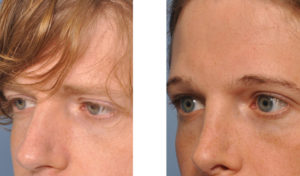There are numerous surgical procedures to feminize a masculine facial appearance. They include jawline reshaping (chin and mandibular angle reduction), rhinoplasty, cheek reduction, tracheal shave and forehead reduction/reshaping. While every transgender patient’s face is different and may need just a few or all of these facial feminization procedures, the forehead is one of the top considerations for most patients. The female forehead has a very distinct shape with a rounded contour from the brows up to the hairline with no obvious bone break.
Forehead reshaping incorporates reduction of the prominence of the central glabellar region as well as the projection of the brow bones. The brow bones must not only be deprojected but should also have the tail of them near the lateral orbit reshaped to have more of a sweeping effect up and towards the temples. Since this procedure requires an open scalp approach, this creates the oportunity to lower the frontal hairline as well. Together this type of foreheadplasty has a significant impact on the gender identification of the face.

When significant brow bone reduction is done (flattening of the bone), there is the potential for an excess of overlying skin. Loose skin on the brows can result in sagging or overlying brow ptosis. This can be easily addressed at the time of the brow bone reduction by a comcomitant browlift using the transcoronal or hairline incision made for access to the brow bones. An alternative approach is a direct browpexy from the galea below the eyebrows to underlying bone holes or the fixation plates (if used) above the reshaped brow bones.
A final component of the feminizing foreheadplasty procedure is the potential to simultaneously lower the frontal hairline. A long forehead (> than 6.5 to 7 cms between the brow and hairline) is unaesthetic for any gender but is particularly so in the male to female transgender patient. If a hairline approach (trichophytic) is used, a simultaneous scalp advancement can be done by securing the galea of the advanced scalp by sutures to bone holes in the outer table of the skull. By bringing the scalp forward, the lifted forehead skin will need to be trimmed creating a combined forehead skin reduction and browlift.
Ultimate feminization of the forehead can be done by simultaneous brow bone reduction, browlift and hairline lowering.
Dr. Barry Eppley
Indianapolis, Indiana


